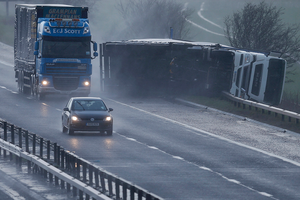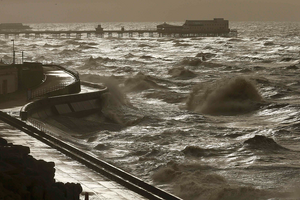Gale winds in Scotland forced waterfall to flow up
Winds up to 105 miles per hour, caused by Storm Henry, caused this unusual phenomenon.

Zac, a bearded collie, runs on the beach in Ardrossan, Scotland, on Friday, Jan. 29, 2016, as a storm reaches the United Kingdom. Winds of over 90 mph have hit the west of Scotland as Storm Gertrude hit the country, causing power cuts and travel disruption.
Danny Lawson/PA
Perhaps there’s no better indication that a storm means business than when its winds force a waterfall to flow up instead of down.
This is exactly what happened Tuesday in Scotland – already considered the windiest European country – where the second storm in a week has caused havoc across the country and the rest of Britain.
A video circulating on the Internet, shot by a company on Mull, an island off the west coast of Scotland, shows 90 mile-per-hour winds blowing a waterfall in the wrong direction.
“The stormy winds on Mull today were turning the waterfalls upside down!” Isle of Mull Cottages, the company that shot the video, said in a post on Facebook.
With winds reaching speeds of 105 miles per hour in some locations, last week’s Storm Gertrude and this week’s Storm Henry brought rain, flooding and gale-force winds that shut down schools, left thousands of homes without power, canceled trains, flights and ferries, and closed bridges. The storm blew trucks off the highway, and caused 14-meter (46-foot) high waves to crash along Scotland's coast, as the Scotsman reported.
Scotland’s hospitals treated patients who miraculously made it to its front doors, many hurt by getting knocked into things by the prodigious winds.
“A poor man had been smashed against the bus stop outside the hospital and was lying in a pool of blood and glass, unconscious. People were being blown around like paper dolls,” an unnamed eyewitness told the Scottish newspaper.
Though Storm Henry battered Scotland hardest, strong winds tore through all of the United Kingdom. There were wind gusts of over 60 m.p.h. (97 k.p.h.) in northern Ireland and northern England. Southern England saw wind gusts of 40-50 mph (65-80 km/h), reported AccuWeather.com
As of Wednesday, Henry has receded, leaving behind a spectacular light show in the sky in some areas. It is caused by a cloud formation called nacreous, which forms very high in the atmosphere where temperatures are extremely cold, its iridescent colors caused by sunlight bending as it passes around tiny ice crystals in the clouds.
But the radiance of the clouds is misleading, because nacreous clouds are actually destructive to our atmosphere, as The Guardian has pointed out.
“Their presence encourages the chemical reactions that break down the ozone layer, which acts as an essential shield protecting us from the most harmful of the sun's rays,” wrote the Guardian.



